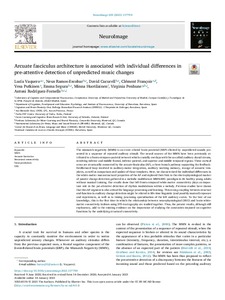Arcuate fasciculus architecture is associated with individual differences in pre-attentive detection of unpredicted music changes
Ramos-Escobar Neus; Segura Emma; Rodríguez-Fornells Antoni; François Clément; Penhune Virginia; Huotilainen Minna; Putkinen Vesa; Cucurell David; Vaquero Lucia
https://urn.fi/URN:NBN:fi-fe2021042825202
Tiivistelmä
The mismatch negativity (MMN) is an event related brain potential (ERP) elicited by unpredicted sounds presented in a sequence of repeated auditory stimuli. The neural sources of the MMN have been previously attributed to a fronto-temporo-parietal network which crucially overlaps with the so-called auditory dorsal stream, involving inferior and middle frontal, inferior parietal, and superior and middle temporal regions. These cortical areas are structurally connected by the arcuate fasciculus (AF), a three-branch pathway supporting the feedback-feedforward loop involved in auditory-motor integration, auditory working memory, storage of acoustic templates, as well as comparison and update of those templates. Here, we characterized the individual differences in the white-matter macrostructural properties of the AF and explored their link to the electrophysiological marker of passive change detection gathered in a melodic multifeature MMN-EEG paradigm in 26 healthy young adults without musical training. Our results show that left fronto-temporal white-matter connectivity plays an important role in the pre-attentive detection of rhythm modulations within a melody. Previous studies have shown that this AF segment is also critical for language processing and learning. This strong coupling between structure and function in auditory change detection might be related to life-time linguistic (and possibly musical) exposure and experiences, as well as to timing processing specialization of the left auditory cortex. To the best of our knowledge, this is the first time in which the relationship between neurophysiological (EEG) and brain white-matter connectivity indexes using DTI-tractography are studied together. Thus, the present results, although still exploratory, add to the existing evidence on the importance of studying the constraints imposed on cognitive functions by the underlying structural connectivity.
Kokoelmat
- Rinnakkaistallenteet [19207]
